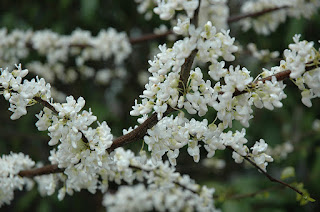 |
| Bumblebees like a spacious landing pad |
Come to think of it, all pollinators aren’t the same, so it’s not surprising that they need different things from flowers. I was eager to see how I was doing with the types of insects Jessica described.
Bumblebees are big and heavy enough to pop open flowers to get at enclosed nectaries. That means they benefit from lupines, snapdragons, and many pea-type flowers, including my white redbud (Cercis canadensis f. alba).
 |
| Redbuds' flower shape show they're in the pea family, Fabaceae |
I do have some native lupines, and I enjoy snapdragons. The challenge will be to find some this year that aren’t treated with neonicotinoids. Jessica points out that spraying pesticides will harm pollinators, making your whole planting effort moot. Bumblebees also have long tongues that enable them to extract nectar from flowers with deep throats, such as my phlox, bee balm, and salvias.
 |
| Phlox 'David' |
Thousands of species of native bees (North America has 4,000 in all) are tiny insects that need plants with lots of small flowers. They like daisy flowers such as black-eyed Susans (Rudbeckia species).
 |
| Black-eyed Susans work for smaller bees |
I’ve got lots of these popping up all over, thanks to their generous self-seeding. A daisy’s central disc is actually packed with many small flowers, each offering pollen for these little bees. Sunflowers and coreopsis provide the same architecture.
 |
| A sunflower's central disc contains many tiny flowers |
Small bees also like the tiny clusters of flowers sported by plants such as my goldenrods (Solidago species).
 |
| Goldenrod goes for quantity over size |
Native bees don’t build hives. They’re mostly solitary, often raising their young in holes in the ground or in hollow stems, which they may also shelter in during the winter. Last fall I followed Jessica’s advice and left flower stems standing.
 |
| Don't just take it from me. New York's High Line leaves coneflowers standing too. |
They’re looking kind of messy now, but I hope to see more pollinators this spring. I learned from this post that I could cut them to 15 inches high if I don’t want them flopping over. Some of the plants I grow that have hollow stems are purple coneflowers (Echinacea purpurea), raspberries, and ornamental grasses.
Pollinators need flowers blooming throughout the growing season. Witch hazel is offering some pollen now. Other early bloomers that will help in my yard include bugleweed (Ajuga species), catmint (Nepeta species), and shadbush (Amelanchier canadensis). At the end of the season, asters, goldenrods and sedums help keep the buffet open.
 |
| A monarch found this New England aster |
Jessica confirms something I learned recently. Double flowers don’t do anything for pollinators. That’s because in breeding for doubleness, the pollen-carrying stamens are converted into extra petals. Even if the insects could fight their way through to the flower’s center, there’s no nectar there for them to get. So when you’re confronted with dozens of coneflower cultivars, skip the double ones if you’re shopping to please pollinators.
 |
| These double coneflowers don't offer nectar or pollen |
No comments:
Post a Comment